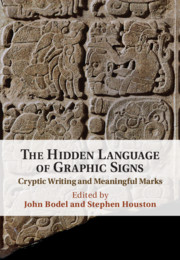Book contents
- The Hidden Language of Graphic Signs
- The Hidden Language of Graphic Signs
- Copyright page
- Contents
- Contributors
- Abbreviations
- Introduction
- Part I Hidden Writing
- Part II Legible Signs
- Seven Marking and Writing in an Egyptian Workmen’s Community
- Eight The Semiotics of Signa and the Significance of Signs in Roman Stamps
- Nine Late Antique and Early Medieval Monograms
- Ten Crests and Familial Identity in Medieval Japan
- Eleven Where Credit’s Due
- Twelve From Modeling to Destruction
- References
- Index
Nine - Late Antique and Early Medieval Monograms
From Producers’ Marks to Liminal Graphic Devices
from Part II - Legible Signs
Published online by Cambridge University Press: 23 August 2021
- The Hidden Language of Graphic Signs
- The Hidden Language of Graphic Signs
- Copyright page
- Contents
- Contributors
- Abbreviations
- Introduction
- Part I Hidden Writing
- Part II Legible Signs
- Seven Marking and Writing in an Egyptian Workmen’s Community
- Eight The Semiotics of Signa and the Significance of Signs in Roman Stamps
- Nine Late Antique and Early Medieval Monograms
- Ten Crests and Familial Identity in Medieval Japan
- Eleven Where Credit’s Due
- Twelve From Modeling to Destruction
- References
- Index
Summary
This chapter investigates the interplay of textual and non-textual features in the marking systems of three types of clay products widely used in Roman Italy during the first three centuries CE ‒ fine tableware (sigillata), shipping containers (amphorae), and bricks and tiles. The semiotic flexibility of the footprint as a polyvalent sign indicating both authorship and identity is illustrated by its use as a stamp on Roman tableware. The marks employed on amphorae to identify different phases of the manufacture, transport, and distribution of the vessels or their contents reveal a well-defined taxonomy of textual and atextual signs differentiated according to medium, placement, and stage of application. Brickstamps on larger bricks at Rome combined texts with semantically distinctive figured symbols (signa) in complex messages that identified brickyard owner, manufacturer, and origin; smaller bricks, when marked, bore distinctive patterns of atextual designs created by matrix. Atextual marking systems operated both together with and independently of textual markers, offering different advantages of utility (visual comprehensibility without need of literacy) and facility (being easily constructed out of everyday objects) in return for less semantic precision and differential range.
- Type
- Chapter
- Information
- The Hidden Language of Graphic SignsCryptic Writing and Meaningful Marks, pp. 199 - 213Publisher: Cambridge University PressPrint publication year: 2021
- 1
- Cited by



